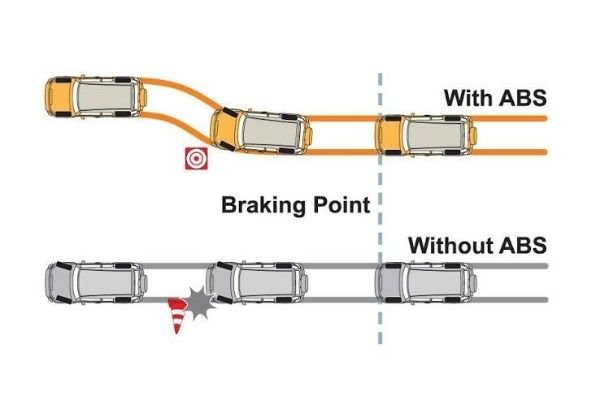Safety features form a very integral part of any automobile, though, conventionally, it has not really been sought as the must-have feature for the majority of Indian buyers, they have grown aware of their criticality of late. Apart from the basic features like airbags, seatbelt, and immobilizer, modern auto marvels pack in a lot more advanced safety features, which might sound overwhelming at first.
This article intends to explain some of the advanced safety features in simple, straightforward, and understandable terms.

1. ABS (Anti-lock braking system)
As the name suggests, ABS is an electric system that prevents a vehicle’s brakes from locking and is especially useful on slippery/skiddy surfaces.
What is ABS?
To put the definition formally, ABS can be defined as an electronic system that monitors and keeps under check skidding/slipping of the vehicle during braking. It controls the slipping by preventing the wheels from locking up on the sudden application of brakes.
ABS facilitates shortened braking distances on slippery surfaces by allowing the driver to maintain better control on the steering wheel, it really comes handy on excessive slippery wet and ice surfaces.
Not a second brake system
The anti-lock braking system on a vehicle is simply an additional monitoring and controlling function that works in conjunction with the braking system in place. It is superimposed on the existing vehicle brake system and not a second-brake system, it cannot replace the braking system and always works with the braking system
Not an accessory
Many uninformed car buyers believe that ABS is an auxiliary addition and can be installed as an after-market inclusion, which is completely false. It is an electronic system that comes factory fitted and cannot be installed as an after-market addition
Why is it needed?
On the sudden application of brakes, due to the formation of excess friction force, wheels tend to lock up. This leads to a weakened contact between the tire and the road which results in skidding of wheels on the road.
As mentioned above, wheels lock up on the forceful application of brakes and as a result, the steering does not work, this eventually leads to an inability to steer the vehicle but if ABS is in place, it will not allow the wheel to lock up thus safeguarding the occupants inside the cabin.

2. Electric Brake Force Distribution (EBD)
What is EBD?
It is an automobile brake technology that is responsible for varying the amount of force applied to each vehicle’s wheel. The distribution of brake force depends on a variety of factors including the road conditions, speed, and loads on different wheels.
It works together with the ABS and applies more or less braking pressure to each wheel in order to maximize stopping power while maintaining vehicular control.
EBD works on the basic idea that it is not necessary to apply the same amount of braking force on each wheel in order to stop it completely.
Why is EBD needed?
Some wheels will require a greater brake force in order to stop the vehicle while maintaining complete control over the vehicle. It is also important to note that the amount of weight supported by a wheel change on the application of brakes, it results in a rapid change in total force required in order to stop the vehicle.
EBD system detects the amount of weight that is being supported by each wheel and accordingly changes the amount of braking power sent to each wheel.

3. Traction Control
What is Traction Control?
It is a computer-controlled system on the vehicle that is responsible for keeping track of the wheel slippage if it comes to its notice that one wheel is spinning faster than the others, it will apply the ABS to that wheel and cut engine power to the wheel.
Many modern vehicles come equipped with this program to restore traction on slippery surfaces. Its purpose is to provide vehicle traction on low-friction surfaces where the tire finds it difficult to establish a firm group on the road.
It is also important to note that it can never create traction in the first place if there is not any, to begin with, and will come into action only if there is a need to re-establish traction.
Why is it important?
On excessively slippery surfaces, the vehicle might easily lose the traction with the road, it will result in difficulty in navigating because the tire does not have a strong grip on the road, Traction control systems will prevent the wheels from spinning in such conditions, and help in establishing a firm grip over the road surface.
How is it different from ABS?
Though the two might sound the same, a large difference exists in their working, The basic difference between ABS and traction control lies in their function itself. While the former stops the wheel from locking during sudden braking, the latter stops the vehicle from slipping while the vehicle is still accelerating.
4. Cornering Stability Control
What is it?
It is an active vehicle safety system that assists the driver during while it manoeuvers a curve at high speed. While some manufacturers consider it to be the sub-part of the Electronic Stability System (ESP), some also define it as an extension of the Anti-lock braking system.
Why is it needed?
When a vehicle moves along a circular road, a centripetal force acts constantly on it, it always acts in a direction opposite from the center of the curvature and tends to throw the weight of the vehicle away from the center. As a result, the inner wheel might lose some traction.
This situation can create an overall imbalance in the behavior of the vehicle it can also create the possibility of vehicle getting drifted away from its intended path, which can prove to be harmful and poses a serious threat.
With the Cornering stability control system in place, the system is continuously able to monitor vehicle behavior in such situations. This system makes sure that brakes are applied on the inner wheels in such situations. This makes sure that the centripetal force is compensated out.

5. Hill-hold control
What is it?
An electronic system in place that detects the tilt of the body when the car is stopped on a slope. It sends the signal to the vehicle’s brake hardware to keep the car planted for a few seconds after the driver releases the brake pedal.
Why is it needed?
While the primary reason behind the inclusion of hill hold control feature is obvious, that is it makes sure that the car does not roll backward when it is stopped on sloped terrain.
It also ensures that there are lesser wear and tears on the other parts of the car-like handbrake which might have been used to serve the same purpose manually.
Though Hill-hold control is not absolutely critical for a safe driving experience like Airbags or ABS, its presence will definitely contribute towards a hassle-free experience in daily life.

6. Descent Control
What is it?
Hill descent control is an assistance system that comes into play when a vehicle is coasting down a steep slope.
The main function of the Descent control system is to assist the driver by restricting the top speed of the vehicle to a predetermined value while traveling down on a steep slope. This allows the driver to concentrate on the speed only and thus the driver has better control of the vehicle.
Why is it needed?
As mentioned earlier, it becomes hard to control the vehicle on a steep slope because the driver effectively needs to keep control of both steering and the brake but with the Hill descent control in place, it limits the speed, and thus driver’s work is eased out.








